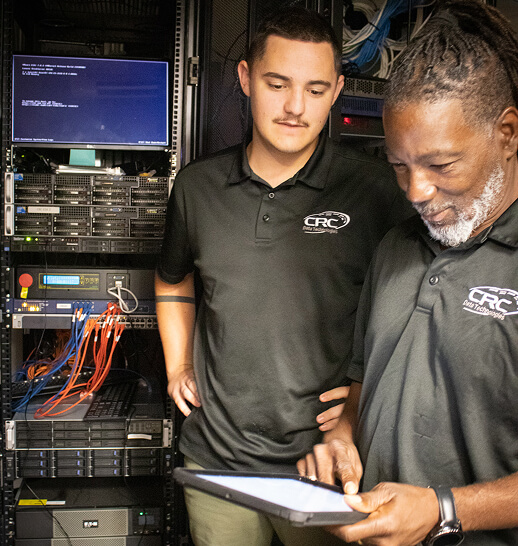Our clients trust us to deliver.
We lead with clarity and care.
“CRC Ended Our Downtime”
"The amount of time CRC has saved us, between the efficiency and streamlining has cut our downtime to zero, CRC was able to fix our rat’s nest! Before, we had 4-5 different I.T vendors that we had used, who would just patch the mess. CRC came in, cleaned up our server room and redid our cabling and network. CRC WAS ABLE TO FIX OUR RAT’S NEST!"

DANA W.
Restaurant
“10 Years of Reliable IT Support"
"For over 10 years CRC has been very responsive to our needs and willing to work hand-in-hand for us to accomplish our goals. They have gone out of their way to meet our needs, even when we aren’t aware of them. A really great organization. WE CHOSE CRC DUE TO THE QUALITY OF WORK AND THE RESPONSIBILITY THEY TAKE IN MAKING SURE OUR SYSTEMS ARE ALWAYS UP AND RUNNING."

GARY W.
Methodist Church
"Reliable Protection & Management"
"Over the years CRC has helped protect us from cyber attacks and manage our systems. They were there to assist us when we received threatening letters, later discovering they were scam attempts. It’s a smart use of our resources having CRC, we have been able to grow and respond to changes over the years, which has made us successful. CRC HAS HELPED PROTECT US FROM CYBER ATTACKS AND MANAGE OUR SYSTEMS"

LOCKWOOD W.
Utilities

Why Partner With CRC Data Technologies?
Serving Northwest Florida businesses since 1992.
CRC Data Technologies helps businesses eliminate IT problems, improve operations, and stay secure. Based in Destin, we bring local expertise, clear communication, and fast support to organizations across the Emerald Coast. Let our team take the stress out of managing your IT.
Are you tired of dealing with the same IT problems over and over?
Schedule a 15-minute discovery call to find out how your IT could be improved.
CRC Data Technologies
Fixing Your IT Issues Before They Escalate
We Prevent IT Problems From Affecting Your Bottom Line.
CRC Data Technologies helps businesses focus on what matters by eliminating recurring IT headaches. From cybersecurity risks to unreliable networks, we take full responsibility for your tech stack so your team stays productive & protected.
Our support isn’t just fast — it’s human. We show up when it counts, communicate clearly, and solve issues without the runaround. No finger-pointing, no confusion, no surprises. Just expert IT that works, day in and day out.
Schedule a call with our local team to experience what dependable IT support really feels like.

Our Suite of IT Services
We deliver clear, reliable support and solutions for businesses across Northwest Florida. Our team helps you avoid costly downtime, secure your systems, and stay focused on your goals. These are the core services CRC offers to keep your business running smoothly:
Cybersecurity & Compliance
We deliver advanced cybersecurity that protects your IT from evolving threats and ensures full compliance. Our team keeps your systems secure and current.
Fully Managed IT
We support your staff and manage IT assets with process-driven strategies, helping your systems run efficiently and business operations stay seamless.
Co-Managed IT
We work with your IT team to enhance capabilities, supporting projects, migrations, and compliance while ensuring smooth, secure operations.
Cloud Service & Hosting
Private and public cloud solutions tailored to your business needs. From hosting to server management, we help optimize performance, security, and scalability.
VoIP Phone Systems
Modern multi-office & mobile workforce communications that ensure your team stays connected even when internet service disruptions occur.
Our Certifications and Partners
Trusted Experts Backed by Leaders
We work with leading technology providers to deliver reliable, secure, and modern IT solutions. Our team maintains industry certifications and long-standing partnerships that support our commitment to quality. These relationships help us provide trusted products, expert service, and up-to-date solutions that meet the demands of growing businesses across Northwest Florida.



Sign Up In Our Email Newsletter
Learn Everything You Don't Know About IT, In the Context of You & Your Company.
Keeping your IT ahead of the curve is a full-time job (and then some). That’s why we make it a point to educate businesses on the principles of IT before they make any big decisions. We’ve crafted an email course to explain:
Best practices for effective, secure and reliable use of IT assets at your place of business.
What IT news you need to be aware of (and why), so you can stay ahead of the curve.
How simple changes in the way you think about IT can positively affect your business' productivity and bottom line.

Tired of IT Headaches?
Solve problems fast with expert IT support and a team that always answers.
Call (850) 655-7444 today to get started with responsive IT services that actually work.
